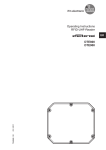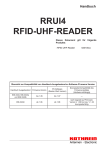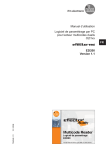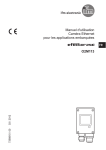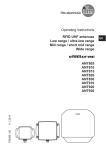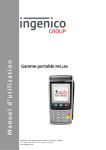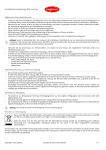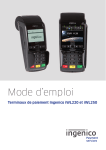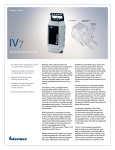Download Operating instructions RFID UHF Sensor Mid Range DTE820
Transcript
Operating instructions RFID UHF Sensor Mid Range 706386 / 00 12 / 2014 DTE820 UK RFID UHF Sensor Content 1 Preliminary note��������������������������������������������������������������������������������������������������� 3 1.1 Symbols used��������������������������������������������������������������������������������������������� 3 2 Safety instructions����������������������������������������������������������������������������������������������� 3 2.1 General������������������������������������������������������������������������������������������������������� 3 2.2 Target group ����������������������������������������������������������������������������������������������� 3 2.3 Electrical connection����������������������������������������������������������������������������������� 4 2.4 Tampering with the device��������������������������������������������������������������������������� 4 2.5 Ventilation��������������������������������������������������������������������������������������������������� 4 2.6 Environmental conditions ��������������������������������������������������������������������������� 4 2.7 Radiated electromagnetic field strengths ��������������������������������������������������� 4 3 Functions and features ��������������������������������������������������������������������������������������� 5 4 Items supplied����������������������������������������������������������������������������������������������������� 5 5 Accessories��������������������������������������������������������������������������������������������������������� 5 6 Characteristics of the antenna ��������������������������������������������������������������������������� 6 6.1 Reading range and tag shape��������������������������������������������������������������������� 6 7 Reading range and selectivity����������������������������������������������������������������������������� 7 8 Conformity with standards����������������������������������������������������������������������������������� 8 9 Installation��������������������������������������������������������������������������������������������������������� 10 9.1 Installation location����������������������������������������������������������������������������������� 10 9.2 Laying of cables ����������������������������������������������������������������������������������������11 9.3 Drilling template������������������������������������������������������������������������������������������11 9.4 Connections and status indication������������������������������������������������������������� 12 9.5 GPIO and RS-232 connection������������������������������������������������������������������� 13 9.6 Ethernet and current supply connection��������������������������������������������������� 14 10 Typical applications����������������������������������������������������������������������������������������� 15 10.1 Access systems��������������������������������������������������������������������������������������� 15 10.2 Automation industry��������������������������������������������������������������������������������� 15 10.3 Further applications��������������������������������������������������������������������������������� 15 11 Abbreviations��������������������������������������������������������������������������������������������������� 16 12 Maintenance, repair and disposal������������������������������������������������������������������� 16 2 RFID UHF Sensor 1 Preliminary note This document is intended for specialists. These specialists are people who are qualified by their appropriate training and their experience to see risks and to avoid possible hazards that may be caused during operation or maintenance of the device. The document contains information about the correct handling of the device. Read this document before use to familiarise yourself with operating conditions, installation and operation. Keep this document during the entire duration of use of the device. UK 1.1 Symbols used ► > […] → Instructions Reaction, result Designation of keys, buttons or indications Cross-reference Important note Non-compliance may result in malfunction or interference. Information Supplementary note 2 Safety instructions 2.1 General These instructions are an integral part of the device. They contain texts and figures concerning the correct handling of the device and must be read before installation or use. Observe the operating instructions. Non-observance of the instructions, operation which is not in accordance with use as prescribed below, wrong installation or incorrect handling can seriously affect the safety of operators and machinery. 2.2 Target group These instructions are intended for authorised persons according to the EMC and low-voltage directives. The device must only be installed, connected and put into operation by a qualified electrician. 3 RFID UHF Sensor 2.3 Electrical connection Disconnect the device externally before handling it. The device can be damaged when the operating voltage is switched on and no LAN cable is connected. Connect a LAN cable to the device before you switch on the operating voltage. The connection pins may only be supplied with the signals indicated in the technical data and/or on the device label and only the approved accessories of ifm may be connected. 2.4 Tampering with the device In case of malfunctions or uncertainties please contact the manufacturer. Any tampering with the device can seriously affect the safety of operators and machinery. This is not permitted and leads to the exclusion of any liability and warranty claims. 2.5 Ventilation During operation the device must be sufficiently ventilated. Install the device only in places where ventilation is ensured. With insufficient ventilation there is a risk of fire. 2.6 Environmental conditions Do not place the device in the vicinity of heaters, do not expose it to direct sunlight and do not operate it in wet environments. No objects with open flames must be placed onto the device. Protect the device against moisture, falling water drops and splashing water. Observe the environmental conditions indicated in the technical data sheet. There is a risk of fire in unsuitable environmental conditions. 2.7 Radiated electromagnetic field strengths The device complies with the requirements to CE. Brand name: ifm electronic DTE820 RFID-UHF sensor for Europe The DTE820 is designed for operation in accordance with EN 302208. During operation the human exposure regulations to EN50364 have to be observed. Ensure a minimum distance of 23 cm between antenna and human bodies. During operation cardiac pacemakers of people in the vicinity may be impaired. In case of doubt, persons concerned should consult the manufacturer of the pacemaker or their doctor. Reduce the output power of your device depending on the antenna cable length and the antenna gain. 4 RFID UHF Sensor 3 Functions and features The DTE820 RFID UHF sensor integrates a mid-range RFID UHF antenna and an RFID UHF reader to process the antenna signals. The device is suited for reading and writing active and passive RFID tags in the frequency range of 865 - 868 MHz. The DTE820 has a PoE Ethernet interface and a serial interface. In addition digital inputs and outputs (GPIO) are available. The device can be supplied with voltage either via PoE or locally. On delivery the device can read and write tags according to the EPC Gen2 standard. Other protocols can be uploaded via software updates. UK Knowledge of the EPCglobal GS1 standard is necessary for the configuration of the DTE820. In this standard the function of the interface between tag and reader is described. Further information at: www.epcglobalinc.org. The DTE820 can be controlled and evaluated in various ways: ●● Software ReaderStart ●● Supplied DLL ●● Access to the reader protocol 4 Items supplied ●● DTE820 RFID UHF sensor ●● CD with demo software, example programming, DLL and documentation 5 Accessories The following accessories are available for the DTE820: If you have any questions about the accessories, please contact our sales team. ●● Connection cable for Ethernet and current connection (PoE), article no. E11898 ●● Mast and wall fixture, article no. E80340 for mounting RFID antennas, DTE readers and sensors (up to a total weight of 6.0 kg). ●● Connection cable for GPIO and RS-232 connection, 12 poles, article no. for 1.5 m ZB0643, article no. for 5.0 m: ZB0656. 5 RFID UHF Sensor 6 Characteristics of the antenna The RFID UHF antenna integrated in the DTE820 is a mid-range antenna which meets the requirements of many RFID applications. Mid-range antennas have been developed for applications in the near and far field. Special attention was paid to a small design for integration in compact environments. For dimensions of 156 x 126 reading ranges of more than 2 m are nevertheless possible. Mid-range antennas also have an increased selectivity at lower read distances as compared to conventional antennas. That means that they are suitable for the transition range with various tags. 6.1 Reading range and tag shape Reading range Tag shape loop-shaped hybrid-type dipole-type 10-30 cm 30 - 100 cm > 100 cm The correct combination of antenna and tag is essential for every RFID application. This ensures a high reading rate and reliable system operation. 2m 1m DTE820 100° 30 ERP 4m 2m Figure: DTE820 reading range 6 0 2m 4m RFID UHF Sensor 7 Reading range and selectivity The reading range and the selectivity are the most important features of an RFID application. The reading range describes the greatest distance at which a tag can be read. The selectivity indicates the required minimum distance for clear distinction between two adjacent tags. The system features depend considerably on the tag type used. In general, the UHF RFID tags can be divided into three groups: The first group consists of small, loop-shaped tags (near field tags) with an average diameter of 2 cm that mostly couple with the antenna magnetically. These tags have the smallest ranges since the magnetic field decreases rapidly with the distance of the antenna. The second group consists of hybrid-type tags which are a mix of loop-shaped and dipole-type tags. These tags can be activated by the antenna via the magnetic field, the electric field or a combination of both. The third group is made up of dipole-type tags (far field tags) which mostly couple via the electric field. Ranges of more than 10 m are possible. Reading range Selectivity Figure: RFID UHF sensor detects tag at short distance Figure: Illustration of reading range and selectivity 7 UK RFID UHF Sensor 8 Conformity with standards Since the RFID systems are radio systems, they are in the scope of the 1999/5/EC guideline of the European Commission (Radio and Telecommunications Terminal Equipment R&TTE). As evidence of the conformity with the basic requirements of this guideline there is a number of harmonised standards that are published in the Official Journal of the European Union. The ifm antennas have a passive antenna structure. The system integrator is responsible for meeting the standards. Therefore it is expressly recommended to acquire these standards. Two important standards in connection with antennas are (not exhaustive) EN 302208 and EN 50364: The first one deals with radio spectrum matters and limits the maximally radiated power while EN 50364 deals with the limitation of human exposure to electromagnetic fields. As evidence of the antenna conformity with the standard EN 50364 the specific absorption rate (SAR) is calculated numerically. The determined SAR values are compared with the basic limit values of EN 50364 - classified to occupational exposure, exposure of the general public and local exposure of head and trunk and limbs. The WiRa is in general used for applications with a reading area starting with 20 cm. At this distance the values are significantly below the maximum SAR values permitted by law. In case that use is intended for smaller distances, the respective SAR values are numerically calculated. The assumptions taken as basis (such as operating mode of the RFID system and characteristics of the human tissue) ensure a conservative estimate of the exposure (worst case scenario). The calculation was also made for the most sensitive constellation i.e. for the case that members of the general public stay permanently in direct vicinity of the antenna with their head or trunk. If the distance between the person and the antenna is less than 3 cm, the DTE820 ensures that the maximally allowed SAR is not reached with an antenna input power of up to 0.34 W (25.31 dBm). In all other cases the DTE820 can be operated with the maximally radiated power of 0.5 W ERP (27 dBm) or an antenna input power of 0.653 W (28.15 dBm). The table below shows the maximum input powers with which the antenna may be supplied to ensure that the basic limit values of the SAR are not exceeded. Two different types of exposure are differentiated: 8 RFID UHF Sensor Max. input power General public Limit values head and trunk 2 W/kg Limit values local limbs 4 W/kg Occupational exposure Limit values head and trunk 10 W/kg Occupational exposure Limit values local limbs 20 W/kg Distance person and DTE820 < 1 cm 1 cm < distance person and DTE820 < 7 cm Pin = 0.32 W Pin = 1.75 W 7 cm < distance person and DTE820 Pin = 1.84 W Pin = 1.84 W Pin = 1.84 W UK 9 RFID UHF Sensor 9 Installation 9.1 Installation location The operating principle of the antenna is influenced by the type of installation and the environment. Observe the following remarks for the selection of the installation location: ●● Keep a distance of min. 70 cm to metal surfaces and the ground (see Figure 1). ●● When installed in front of a metal surface, use a mounting bracket that establishes a distance of exactly 12 cm between the back of the device and the metal surface (see Figure 2). ●● With direct installation on a metal surface (e.g. a plate as part of a mounting bracket) use a square-shaped metal plate with the dimensions 16 x 16 cm (see Figure 3). ●● Avoid conductive objects such as tanks with liquids in the vicinity of the installation location. The objects influence the performance of the antenna. min 70 cm ●● Ensure sufficient heat dissipation at the installation location. The maximum operating temperature indicated in the data sheet must not be exceeded. 12 cm min 70 cm min 70 cm min 70 cm max 16 cm max 16 cm Figure 1: Distance to all sides min. 70 cm Figure 2: Distance between device and metal surface exactly 12 cm Figure 3: Metal surface with max. 16 cm x 16 cm If the installation instructions are not adhered to, the antenna characteristics change. The DETE820 must be newly assessed at the mounting location. 10 RFID UHF Sensor 9.2 Laying of cables Observe the following notes when laying the cables: ●● Lay the cables vertically and straight away from the sensor (see figure on the right). ●● Avoid cable loops around and on the sensor (see figure on the left). UK X Figure: Incorrectly laid cable Figure: Correctly laid cable 9.3 Drilling template The DTE820 is fixed to the ground using 4 screws. The bore hole distances are indicated in the following drawing. A fixture allowing installation on a mast is available as accessory. 4,5 110 140 11 RFID UHF Sensor 9.4 Connections and status indication The DTE820 is controlled and evaluated via two connections and a status indication. The following sections describe the connections and the status indication. 1 2 3 1 GPIO and RS-232 connection, M12 female, 12 poles 2 Status indication, 2-colour LED (red, green) 3 Ethernet and current supply connection, M12 female, 4 poles, D-coded Load digital inputs and outputs with max. 0.5 A. Load all digital inputs and outputs used with max. 1.5 A in total. When using the auxiliary voltage (24 V DC, pin7), load the digital inputs and outputs with max. 1.1 A. Load digital inputs and outputs with max. 30 V DC. Use LPS (Limits Power Source) or NEC class 2 power supplies as external voltage source. Observe the additional notes in the data sheet. 12 RFID UHF Sensor 9.5 GPIO and RS-232 connection The 12-pole M12 socket of the DTE820 provides the digital inputs and outputs (GPIO) and the serial interface. 9 8 12 1 10 2 7 6 5 3 4 11 Pin Connection 1 GPIO - OUT3 2 GPIO - GND 3 GND 4 RS-232 - GND 5 RS-232 - RxD 6 RS-232 - TxD 7 24 V DC 8 GPIO - OUT2 9 GPIO - IN3 10 GPIO - OUT1 11 GPIO - IN2 12 GPIO - IN1 UK The digital inputs are not electrically isolated from the operating voltage of the DTE820. The DTE820 is operated with its own voltage supply. DTE +UB +UB INPUT 1 INPUT 2 INPUT 3 INPUT 1 INPUT 2 INPUT 3 GND GND Non-electrically isolated circuit of the inputs 13 RFID UHF Sensor The digital outputs are not electrically isolated from the operating voltage of the DTE820. DTE +UB +UB OUTPUT 1 OUTPUT 1 OUTPUT 2 OUTPUT 2 OUTPUT 3 GND OUTPUT 3 GND Non-electrically isolated circuit of the outputs 9.6 Ethernet and current supply connection The DTE820 is connected to the Ethernet via the 4-pole M12 socket (D-coded) and supplied with current. The current is supplied with PoE (Power over Ethernet). 1 4 2 3 Pin Connection 1 TD+ PoE 1 2 RD+ PoE 2 3 TD- PoE 1 4 RD- PoE 2 Observe the following remarks: ●● Use a power supply with power limitation for the operation. The power supply must not exceed 100 W on the secondary side. ●● Use screened cables. Data transfer via Ethernet with unscreened cables is susceptible to interference. 9.7 LED The operating states of the DTE820 are indicated via a 2-colour LED. The following table explains possible operating states: Operating status Green Red Normal operation Lights permanently Flashes approx. every 8 seconds Device booting Lights permanently Lights permanently Error during booting Flashes approx. every 8 seconds Lights permanently 14 RFID UHF Sensor 10 Typical applications 10.1 Access systems Due to the large reading area of UHF antennas applications for access systems had been implemented via HF RFID so far. The new UHF RFID devices from ifm now allow these applications as well. For access systems such as ski lifts, buses and trains the DTE820 with integrated mid-range antenna is recommended. That means that tickets can now be checked at medium distance. 10.2 Automation industry The DTE820 can be used for RFID automation applications with a defined reading area and high selectivity. Of great advantage is the possibility to detect far-field tags with the ANT805 antenna individually and to read the same tags with DTE820 at other reading stations at larger distances in multi-tag operation. 10.3 Further applications Further typical applications for DTE820: ●● Logistics applications when installed on autonomous industrial transport systems ●● Conveyor technology applications ●● Gate applications for detecting goods ●● Bulk and single tag applications For use of the DTE820 note the effective national regulations and the standards and guidelines valid for the application location. 15 UK RFID UHF Sensor 11 Abbreviations Abbreviations used in the brief instructions: EN ERP European standard Effective Radiated Power RFID Radio Frequency Identification SAR Specific Absorption Rate UHF Ultra High Frequency 12 Maintenance, repair and disposal The device does not contain any components that need to be maintained. ►► Do not open the device. ►► The device must only be repaired by the manufacturer. ►► Dispose of the device in accordance with the national environmental regulations. 16
















